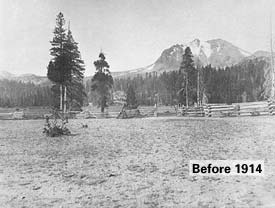The Stone Wall (altho' in California they like to say Rock Walls) Myth Again
I was tracking down the aerial image of the place my friend Alyssa calls the Red Spirit Site, a high meadow in the Mt. Shasta area, when it suddenly occurred to me that here's a fine example of a common sense approach to understanding the difference between the ancient stone rows and modern fences. On the left of the image above, on the hill, are the Ceremonial Stone Rows seen up close in the post "Red Spirit, Near Mt. Shasta CA" {
http://wakinguponturtleisland.blogspot.com/2012/08/red-spirit-near-mt-shasta-ca.html }. On the right are the "fence lines" of a ranch, which I'd guess are probably posts and barbed wire - or perhaps electric fences. Up in the top right hand corner is a possible exception: looks like an interrupted stone row where there maybe wire fencing and posts added alongside of (or possibly even wedged into the stones of) a stone row - the missing pieces now someone's fire place or garden wall, sold off by the rancher or stolen without his permission.
Consider the human history of this area:
Evidence of human occupation of California dates from at the very least 17,000 BCE, with fine-tuned adaptations to local environments. In remote interior regions, like this little area of land near Mt. Shasta, some tribes did not meet non-Natives until the mid-19th century, the time of the California Gold Rush (1848–1855). Barbed wire was invented and marketed about 1875, about 20-30 years or so later.
A little Common Sense sort of question might be: "Which group had the time alone to build the miles and miles of stone rows and all the rest?"
Another Common Sense thing to consider is the human tendency to take the easy way out of any situation, especially when it comes to building fences. The usual progression is usually the fast and easy split rail fences, sometimes those zigzag postless fences called snakes fences or worm fences, whose origin is sometimes thought to be an imitation of Native American hunting fences.
Eric Sloane was kind enough to illustrate many of these fences:
I lifted some images here and there - and many from here, showing these fences way out west: { http://www.siskiyous.edu/shasta/map/hp/ } where you'll find an abundance of photos of wooden rail fences...
...some still hanging around today, handy for stapling barbed wire to.
Ron Smith's photos show a wide variety of modern/historic wire fencing that both makes use of the stone rows or else shows that the stone rows were not the best idea for containing livestock, suggesting that another culture was modifying the landscape for different purposes.
You'll see the details better if you open these in a new window with a right click o'the mouse or use the link to see the photos at Ron's site {
http://www.relicsoftheancients.com/ }.
For example:
I don't know exactly what is going on in the first photo, but the second, I think, clearly illustrates a stone fire break that is also a path that is also full of symbolic representations of Native American Cultural Icons, separating sections of an oak grove that were maintained by Ceremonial Renewal burning when the time was right to do so. The metal posts and barbed wire strands are the easier and less expensive evidence of the Modern Cowboy or Ranch Hand in the current Cultural Landscape.
I also pretend not to know why no one bothers to read the abundant amount of Ethnographic accounts that exist about the Native American cultures of the area that include first hand accounts of stone building by Native People, from John Muir to Alfred Kroeber and to the many people presently interested in the truth about these "stone walls" - other than the fact that it may be related to property rights and the theft of land from Native American People, coming right back to Indians vs Cowboys...







No comments:
Post a Comment